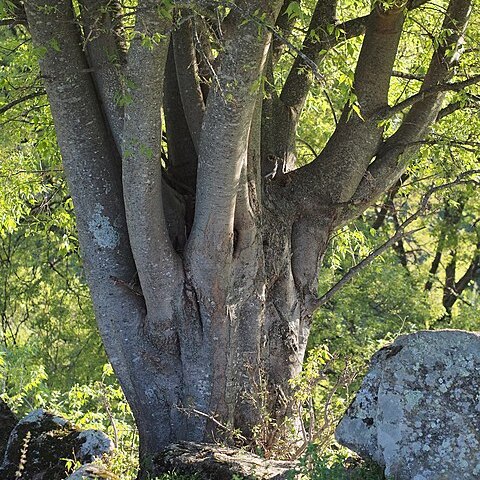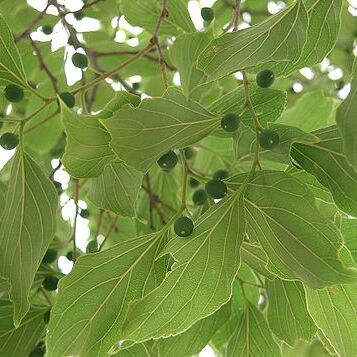Polygamo-monoecious or monoecious shrubs or trees, unarmed or with spinose branches. Leaves alternate, distichous, often inequilateral, serrate or entire; peti-olate; stipules lateral. Inflorescences borne on this year's wood: staminate inflorescence cymose or fasciculate, pistillate inflorescence solitary or few-flowered fasciculate. Flowers small, pedicellate. Bisexual flowers: sepals 4-5, more or less connate at the base; stamens as many as and opposite the calyx lobes, the anther dehiscence extrorse, disc present; ovary sessile, 1-locular, the styles 2, sometimes united at the base, reflexed. Staminate flowers with rudimentary pistil. Pistillate flowers without staminodes. Fruit an ovoid or subglobose drupe, the embryo curved, the cotyledons broad, conduplicate or rarely flat, variously folded.
Trees or shrubs, evergreen or semideciduous, monoecious, sometimes with some bisexual flowers. Leaves alternate, 3-veined at base; stipules lateral, free, scarious, enclosing bud, caducous. Inflorescence axillary on new shoots, a raceme or panicle; bracts minute, caducous. Male flowers globular; perianth lobes 4 or 5, imbricate in bud, free, recurved at anthesis; stamens 4 or 5, exserted at anthesis; anthers dorsifixed, extrorse; pistillode present or absent. Bisexual flowers ovoid; perianth lobes 4 or 5, as for male flowers; stamens 4 or 5; ovary 1-locular, sessile; style short or absent; stigmas elongate, entire or bifid, divergent; ovule pendulous. Female flowers: as for bisexual flowers but stamens reduced to staminodes. Fruit a drupe, ovoid or globose. Seed without endosperm; embryo curved.
Trees or shrubs, monoecious or rarely dioecious, ± armed. Leaf-blades penninerved or 3–5-nerved from the base, which is often unequal-sided, and with cystoliths, giving a scabrous texture to the mature leaves, often present. Stipules usually small and caducous. Inflorescences cymose or fasciculate, the lower ones usually with many predominantly ♂ flowers, the upper ones with few longer pedicelled ♀, hermaphroditeflowers. Sepals (4–)5, free or almost so, imbricate. Stamens as many as the sepals; anthers ovate. Ovary sessile, 1-locular; styles ± 1–2-branched. Drupes thinly fleshy, subglobose to ellipsoid; endocarp hard, sometimes ribbed.
Leaves petiolate, lamina usually unequal-sided at the base, penninerved or 3-nerved from the base; cystoliths often present, giving a scabrous texture to the mature leaves; stipules usually small.
Climbers, shrubs or treelets with spines, monoecious. Inflorescences bisexual or unisexual. Tepals 5; stamens 5 and opposite the tepals; stigmas furcate. Fruit at least 10 mm long.
Flowers often precocious, in many small cymes (sometimes fasciculate in non African species), female flowers sometimes in separate inflorescences.
Trees or shrubs, monoecious rarely dioecious, unarmed (often armed in non African species).
Fruit drupaceous, thinly fleshy, sometimes with ribbed endocarp.
Ovary sessile; styles often once or twice-branched.
Sepals (4)5, ± free, imbricate.
Anthers ovate.



